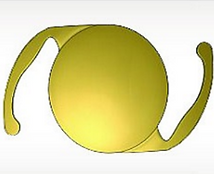

ASPHERIC IOL DESIGN



-
In a young eye, the crystalline lens compensates for the positive spherical aberration (SA) induced by the cornea
-
This SA remains unchanged throughout life
-
-
With age:
-
Lens becomes more positive
-
Total SA of eye increases
-
As a result, the optical quality of eye worsens, reducing contrast sensitivity and resolution
-
Therefore, affects functional vision
-
-
-
-
SPHERICAL IOLs also provide a poor image quality due to an increase in SA induced by the IOL
-
Method to minimise/avoid this is to progressively decrease the lens power towards the periphery, in the form of an ASPHERIC IOL
Different aspheric designs have varying amounts of asphericity to resolve SA:
TECNIS IOL (AMO)
- One of the first aspheric IOLs to compensate for all the positive SA
- This corrected both the CORNEAL and IOL SA
- Corneal topography values show that the average human cornea SA is +0.27µm
- The Tecnis IOL was designed with an altered prolate frontal surface, introducing -0.27µm of SA
- Therefore 'CORRECTING' the aberration
ACRYSOF IQ
- Leaves the patient with a small amount of SA (-0.2µm)
- Reduction of SA carried out by the posterior aspheric surface which deals with the effects of light rays that are over-refracted at the periphery
- Over-refraction causes patients to have decreased image quality due to a region of defocused light
SOFPORT AO (Bausch & Lomb)
- Described as 'SA neutral’ or ‘SA free’
- No alteration is made to the corneal SA
- Achieved with a prolate aspheric curve on either the anterior or posterior surface
- Advantageous as it takes into consideration the variations in corneal asphericity between patients
-
In a comparison between Tecnis and an equivalent spherical design, the Tecnis design showed:
- A better contrast sensitivity at all spatial frequencies
- A reduction in SA of entire eye
- A better modulation transfer function
-
However, showed high image quality degradation in comparison to any other aspherical or spherical designs
-
As a result of mean spherical aberration removal, the Tecnis IOL has provided improvements such as:
-
Enhanced functional vision under mesopic and photopic conditions.
-
-
However, when comparing three aspheric IOLs with their standard spherical counterparts:
-
Although the Tecnis IOL has an increased contrast sensitivity and reduces spherical aberrations, they do not improve functional vision significantly.
-
To correct the actual amount of SA:
- The eyes refractive power and position of the IOLs principle planes should be considered
- As power varies with eccentricity, IOLs should be well centred and resistant to tilt within the eye.
-
Aberration- free IOLs (e.g. Sofport) have shown less sensitivity to a wide range of displacement and tilt compared to aberration-correcting IOLs (e.g. Tecnis)
-
Sofport also provides a better image quality
-
This therefore provides an IOL with a satisfactory compromise between good image quality and the ability to resist decentration and tilt
-
-
IOLs such as the Acrysof IQ, which leave the patient with a residual amount of spherical aberration have improved the depth of focus
-
However, generally SA correction causes a decrease in depth of focus
-